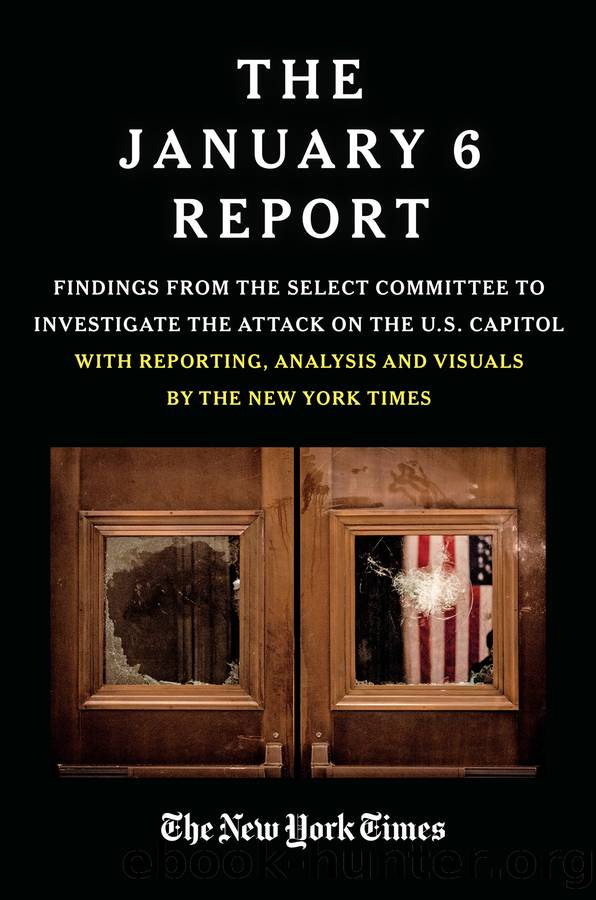THE JANUARY 6 REPORT by The January 6 Select Committee

Author:The January 6 Select Committee [The New York Times]
Language: eng
Format: epub
Publisher: Grand Central Publishing
Published: 2022-12-24T00:00:00+00:00
4.10 DECEMBER 29TH MEETING
The next day, Rosen, Donoghue, and Engel had a meeting with Mark Meadows, Pat Cipollone, and Cipolloneâs deputy, Pat Philbin, in the White House Chief of Staffâs office.222 While the meeting dealt primarily with the Presidential transition, the group discussed a draft civil complaint modeled after Texas v. Pennsylvania that the President wanted the Department of Justice to file challenging the results of the Presidential election, tentatively called United States v. Pennsylvania.223 The DOJ officials said that they had not had time to thoroughly review the proposed suit, but initially indicated that it appeared to be flawed and did not seem âviableâ for DOJ to file.224 Meadows suggested that the DOJ leadership meet with William Olson and Kurt Olsen, the two attorneys affiliated with the Trump Campaign that had been working on the proposed suit, and added that Eastman and a retired judge from North Carolina named Mark Martin both had views about the lawsuit.225
In this meeting, Meadows also raised a new and outrageous allegation of election fraud: that an Italian company had been involved in changing votes in the Presidential election.226 According to Meadows, there was a man, whom Donoghue later learned was in an Italian prison, who claimed to have information supporting the allegation and that CIA officers stationed in Rome were either aware of the plot to interfere in the election or had participated in it.227 Donoghue described how it was apparent that Meadows was not clear on the specifics of the allegation but passed them along to DOJ to investigate, nonetheless.228 Following the meeting Donoghue provided the information to the FBI, which quickly determined that the allegations were not credible.229 Meadows and other senior officials in the Trump administration, however, pressed DOJ to investigate every allegation of fraud regardless of how absurd or specious.
In the days after the December 29th meeting with Meadows, the senior DOJ officials more closely examined the proposed United States v. Pennsylvania lawsuit and determined that DOJ could not file it.230 Engel was principally tasked with examining the veracity of the suit and summarized his analysis in a series of talking points that he provided to Donoghue on December 31st.231 Engel concluded that for multiple reasons, the proposed lawsuit lacked merit. First, the U.S. Government did not have standing to challenge how a State administered its election.232 Such a challenge could only be brought by President Trump as a candidate and his campaign, or, possibly, an aggrieved electoral college elector.233 Second, there was no identified precedent in the history of the Supreme Court establishing that such a lawsuit could be filed by the U.S. Government.234 Third, by late December, States had already certified the results of their elections and the electoral college had met, so suing States by this point would not impact the results of the election.235 Finally, unlike Texas v. Pennsylvania, which was one State suing another State, this lawsuit would not automatically be heard by the Supreme Court, so it should have been filed in a
Download
This site does not store any files on its server. We only index and link to content provided by other sites. Please contact the content providers to delete copyright contents if any and email us, we'll remove relevant links or contents immediately.
The Secret History by Donna Tartt(18860)
The Social Justice Warrior Handbook by Lisa De Pasquale(12143)
Thirteen Reasons Why by Jay Asher(8800)
This Is How You Lose Her by Junot Diaz(6802)
Weapons of Math Destruction by Cathy O'Neil(6152)
Zero to One by Peter Thiel(5692)
Beartown by Fredrik Backman(5609)
The Myth of the Strong Leader by Archie Brown(5429)
The Fire Next Time by James Baldwin(5252)
How Democracies Die by Steven Levitsky & Daniel Ziblatt(5133)
Promise Me, Dad by Joe Biden(5088)
Stone's Rules by Roger Stone(5027)
A Higher Loyalty: Truth, Lies, and Leadership by James Comey(4851)
100 Deadly Skills by Clint Emerson(4845)
Rise and Kill First by Ronen Bergman(4705)
Secrecy World by Jake Bernstein(4652)
The David Icke Guide to the Global Conspiracy (and how to end it) by David Icke(4629)
The Farm by Tom Rob Smith(4442)
The Doomsday Machine by Daniel Ellsberg(4420)
